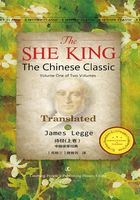
CHUNG-SZE
1 Ye locusts, winged tribes,
How harmoniously you collect together!
Right is it that your descendants
Should be multitudinous!
2 Ye locusts, winged tribes,
How sound your wings in flight
Right is it that your descendants
Should be as in unbroken strings!

St2 ..荒=奄, or 芘覆, 'to cover', 'to overshadow'. The creepers send out their shoots, and cover the branches of the tree. 將 is here best taken as=大, 'to make great'.
St 3 ..成=就, 'complete'. The singers wish the happiness of T'ae-sz', 'from first to last, from the smallest things to the greatest', to be complete.
The rhymes are—in st. 1, 纍, 綏, cat.15, t.1: in 2, 荒,將, cat. 10: in 3, 縈, 成, cat. 11.
Ode 5. THE FRUITFULNESS OF THE LOCUST;SUPPOSED TO CELEBRATE T'AE-SZE'S FREEDOM FROM JEALOUSY. The piece is purely metaphorical (比), T'ae-sze not being mentioned in it.The reference to her only exists in the writer's mind.This often distinguished such pieces from those which are allusive. The locusts cluster together in harmony,it is supposed, without quarrelling, and consequently they increase at a wonderful rate; each female laying,some say 81 eggs, others 99, and others 100.
L.1. in all the stanzas. The 斯 in 螽斯 is by many disregarded, as being merely one of the poetical particles. We shall meet with it as such beyond dispute,and we find 螽 alone, frequently in the Ch'un Ts'ëw.Here, however, it would seem to be a part of the name,the insect intended being the same probably, as the斯螽, in xv., Ode I.5. Maou gives for it the synonym of 蚣蝑, and Choo calls it 'one of the locust (蝗屬)'. But 蝗 will include crickets, grasshoppers, and locusts. We cannot as yet do more than approximate to an identification of the insects in theShe. Williams calls the chung-sze one of the truxalis locusts; but in descriptions and plates the length of the antennae is made very prominent, so that the creature is probably to be found among the achetidoe. 羽 is to be taken as in the translation,=羽蟲, and not as meaning 'wings'. So, Ying-tah. The 'Complete Digest' says, 勿作翅說.
L.3. Maou and his school make 爾 to be addressed to T'ae-sze; Choo refers it, better, simply to the locusts. Those who refer it to the lady try to find some moral meaning, in addition to that of multitude, in the concluding lines. The three second lines are all descriptive of the harmonious clustering of the insects.詵詵 is explained by Choo as the appearance of their'collecting harmoniously', and by Maou as meaning'numerous'. The Shwoh-wăn gives it as 辛 with 多 at the side. We have the character in the text, the form of the Shwoh-wăn, 辛 with 羽 at the side, 先 with 馬at the side, and 生 with another 生 at the side;—all in binomial form with the same meaning. 薨薨 is 'the sound of a crowd of locusts flying'. The bottom of the char. should be 羽, and not 死.
The last line. 振振, is the 'appearance of their multitude'; Maou makes it= 'benevolent and generous'.繩繩,—'the appearance of uninterrupted continuance'; Maou makes it= 'cautious', or 'careful'.

3 Ye locusts, winged tribes,
How you cluster together!
Right is it that your descendants
Should be in swarms!


